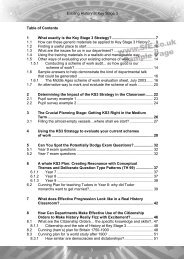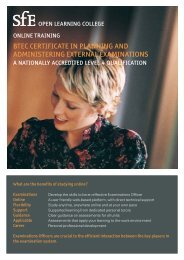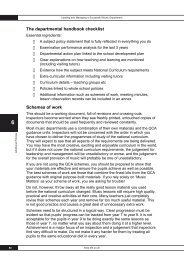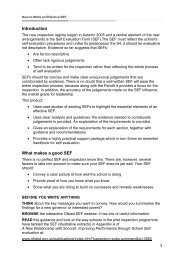Experiential RE supdocs.indd - SfE
Experiential RE supdocs.indd - SfE
Experiential RE supdocs.indd - SfE
You also want an ePaper? Increase the reach of your titles
YUMPU automatically turns print PDFs into web optimized ePapers that Google loves.
Lesson Two: What is Religious Experience? Can it be verified and how far is it a proof of<br />
God? An active literacy lesson.<br />
This lesson follows a period of learning about religious experience using a variety of methods.<br />
The learning has culminated in an experiential re-enactment of Orthodox worship. Pupils have<br />
also had, as part of the term’s work, an experiential lesson on Prayer, the Eucharist and a reenactment<br />
of various forms of baptism, including Orthodox Baptism and Chrismation (the lesson<br />
recipes for these can be found in Teaching Christianity with the Theatre of Learning).<br />
Pupils have studied the arguments for the existence of God and examples of religious experience<br />
using active and experiential methods (see Teaching Philosophical and Abstract Concepts<br />
with the Theatre of Learning). They have written very little. The learning shown in this film is the<br />
product of activity and oral work rather than reading and writing in class.<br />
In this lesson they will prepare for writing an essay at home using the Caterpillar technique<br />
developed by my colleague in the <strong>RE</strong> department, Julie Woodward. She is our school literacy<br />
coach and this technique is now being used by many departments in the school to raise<br />
achievement in examinations.<br />
Aims:<br />
• To prepare an essay on religious experience<br />
• To reinforce learning about religious experience through:<br />
1. Revising key words<br />
2. Introducing the idea of verification<br />
3. Using academic quotation<br />
4. Using a traffic light written exercise<br />
5. Creating a Caterpillar essay to be completed for homework and used for revision<br />
6. Summing up the learning through a traffic light discussion essay.<br />
Outcome:<br />
A twenty mark essay written from a Caterpillar framework; the Caterpillar will provide a useful<br />
revision tool as it is quick and easy to read and retain unlike an essay. The structure will be used<br />
on the exam day to provide a quick planning tool.<br />
Starter: Balloon activity<br />
This activity reinforces knowledge of key words and develops thinking skills and critical faculties.<br />
1. Have enough balloons for each pupil<br />
2. Put vocabulary on card (easier to insert than paper!) in one half of the balloons and<br />
definitions in the other<br />
3. Pupils blow them up and burst them on a signal and find their partners and sit with them<br />
4. Share keywords and their meanings in a circle<br />
5. Draw out deeper knowledge with questioning during the sharing.<br />
Activity One: Caterpillar exercise<br />
1. Pupils collect a sheet of coloured A3 and a felt tip and draw four large circles to represent<br />
the topic for and against and the conclusion<br />
2. Caterpillars are explained<br />
3. The pupils learn to describe the topic in a way to gain maximum marks<br />
16 <strong>Experiential</strong> <strong>RE</strong>: Supporting documents








